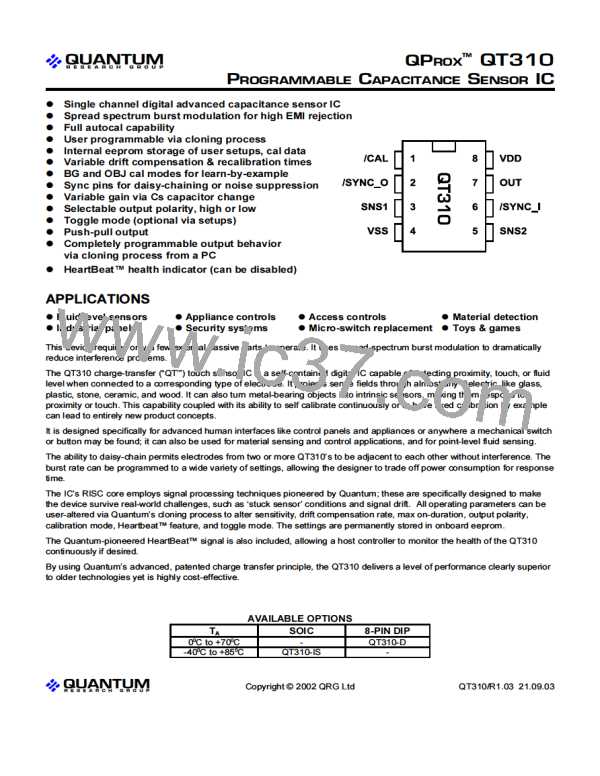DISA / DISB: Because the DI counters count at the burst rate,
slow burst spacings can result in very long detection delays
with terminal counts above 1. To cure this problem, the burst
rate can be made faster while DIA or DIB are counting. This
creates the effect of a gear-shifted detection process: normal
speed when there are no threshold crossings, and fast mode
when a detection is pending.
2.7 OUTPUT FEATURES
Available output processing options accommodate most
requirements; these can be set via the clone process.
If TOG and TOGL modes are disabled, OUT responds to
detections with a steady-state active logic level which lasts for
the duration of a detection, until a MOD timeout occurs
(Section 2.6).
DISA and DISB respectively gearshift the effect of DIA and
DIB. The gear-shifting ceases and normal speed resumes
once the detection is confirmed (DIA = DIAT) and once the
detection ceases (DIB = DIBT).
The OUT pin is push-pull CMOS.
2.7.1 POLARITY (OUTP)
Options: active-low or -high; Default: active-low
When SC=0 the device operates without any sleep cycles,
and so the timebase for the DI counters is very fast.
The polarity of OUT can be set via option OUTP using the
cloning process. Either active-low or active-high can be
selected. This not the same as ‘direction of signal detection’
(Section 2.8.1).
2.6 MAX ON-DURATION (MOD)
Range: 0..255; Default: 14; 255 disables
Affects parameter Tmod, the calibration delay time
In ‘active high’ mode the normal, inactive polarity of OUT is
low; in ‘active low’ mode the normal, inactive polarity of OUT
is high.
If a stray object remains on or near the sense electrode, the
signal may rise enough to activate the OUT pin thus
preventing normal operation. To provide a way around this, a
Max On-Duration (‘MOD’) timer is provided to cause a
recalibration if the activation lasts longer than the designated
timeout, Tmod.
OUTP also selects the initial state of OUT when the sensor is
used in Toggle or Toggle Latch modes (Sections 2.7.2, 2.7.3);
for example, if OUTP is set active-low, the initial state of OUT
after power-up will be high.
The MOD function can also be disabled, in which case the
sensor will never recalibrate unless the part is powered down
and back up again. In infinite timeout the designer should take
care to ensure that drift in Cs, Cx, and Vdd do not cause the
device to ‘stick on’ inadvertently when the target object is
removed from the sense field.
2.7.2 TOGGLE
MODE (TOG)
Options: enabled or disabled; Default: disabled
Toggle mode gives the OUT pin a touch-on / touch-off flip-flop
action, so that its state changes with each new detection. It is
most useful for controlling power loads, for example kitchen
appliances, power tools, light switches, etc.
MOD is expressed in multiples of the burst space interval,
which can be either Tbs or Tbd depending on the Sleep
Cycles setting (SC).
MOD time-outs (Section 2.6) and the /CAL_CLR pin will
recalibrate the sensor but leave the OUT state unchanged.
If SC > 0, the delay is:
The OUTP option (Section 2.7.1) sets the initial state of the
sensor after power-up.
Tmod = (MOD + 1) x 16 x Tbs
Example:
2.7.3 TOGGLE
L
ATCH
MODE (TOGL)
Options: enabled or disabled; Default: disabled
Tbs = 100ms,
MOD = 9;
In this mode, OUT becomes active when a valid detection
occurs but will only go inactive again if an external clear signal
is applied to the part; further detections after the first one will
not change the state of OUT.
Tmod = (9 + 1) x 16 x 100ms = 160 secs.
If SC = 0, Tmod is a function of the total combined burst
durations, Tbd. If SC = 0, the delay is:
Tmod = (MOD + 1) x 256 x Tbd
The external clear signal is applied to the /CAL_CLR pin
which functions only as latch clear input if TOGL is enabled.
The only way to recalibrate the sensor externally in TOGL
mode is to cycle power off and back on.
Example:
Tbd = 18ms,
MOD = 9;
A logic low pulse on /CAL_CLR will clear the latch and make
OUT inactive. As the /CAL_CLR pin is sampled once per
burst, the clear pulse has to be at least as long as Tbs (the
burst duration) to ensure the latch clears.
Tmod = (9 + 1) x 256 x 18ms = 46 secs.
If MOD = 255, recalibration timeout = infinite (disabled)
regardless of SC.
An MOD induced recalibration will make the OUT pin inactive
except if the output is set to toggle mode (Section 2.7.2), in
which case the OUT state will be unaffected but the sensor
will have recalibrated.
If any underlying threshold detection remains active for longer
than the Max On-Duration (MOD) period the device will
recalibrate automatically, but the OUT pin will not change
state.
A clear pulse applied to /CAL_CLR will clear the latch even if
the part is in the process of recalibrating due to a MOD
timeout.
The clear state of OUT can be set via the OUTP option
(Section 2.7.1).
LQ
8
QT310/R1.03 21.09.03

 QUANTUM [ QUANTUM RESEARCH GROUP ]
QUANTUM [ QUANTUM RESEARCH GROUP ]